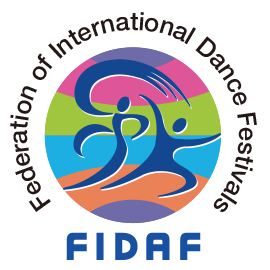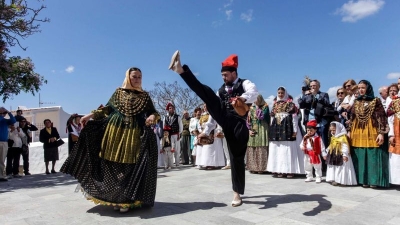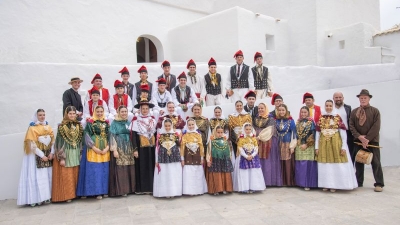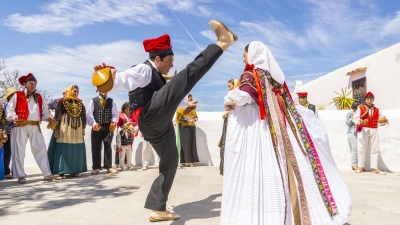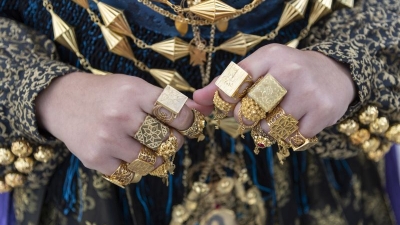SPAIN - Grup de Ball Pages Es Broll de Santa Eularia
Grup de Ball Pagès Es Broll de Santa Eulària / FOLK DANCE GROUP “ES BROLL”, from Ibiza (SPAIN)
Ibiza is the most occidental of the Balearic Islands in the Mediterranean Sea. At 570 km² (squared kilometers) it is the third largest of the Balearic Islands and forms together with Formentera the small Pitiusas archipelago. Furthermore Ibiza is the Balearic Isle lying closest to the Spanish mainland 90 km far from the coast.
Uneven land with small hills of juniper and pines. Soft and dried weather and extremely salted.
Intrepid seamen and good farmers. Cross road of different cultures with 2642 years of known history over its salted shoulders. Sacred land which belong to Carthaginians, Romans, Vandals, Byzantines and Muslims.
Ibiza has been spiritually shaped by most ancient civilizations and isolated during centuries. This situation has made the Ibizan dances unique in the world and preserved pure and original without modern additives. Well known folklorists have qualified them as “Living Fossil” and “Authentic jewel of the Mediterranean dances”.
The group was funded in 1982 and its name means natural fountain which is a good highly appraised in the island.
“Es Broll” is an association created to maintain and spread the “ball pagés” which is the name by our dances are popularly known.
The members of the folk dance group “Es Broll” feel inheritors of our History and want to compile and promote our Ibizan folk dances.
https://www.youtube.com/watch?v=JYhCPFz6FTY
https://www.facebook.com/watch/?v=532195664478100
WOMEN’S COSTUMES
In Ibiza we maintain three different costumes which depend on the epoch not with social conditions as it happens in other sites.
The oldest costume is from 18th century and it’s called the “gonella”. The skirt is tight and black, pleated on the rear side. The apron is embroidered with geometric motifs on the upper part. Both clothes were spun, woven, made up and embroidered at the own home.
The other complements of the costume are a white embroidered shawl, and a “cambuix” and a black hat on the head. The jewels, popularly called “emprendadas”, are made out of coral and silver and gives showiness to the costume.
The bands on the back are only fancy details.
All women wear “espardenyes” with high tips on their feet. This kind of shoes are also hand made at the own home and the material is esparto grass and hemp.
The “white costume” comes from the 19th century. The slimness in the “gonella” is changed into a loose form on sleeves and skirt. Underskirts are worn and the number depends on who wears them but on weeding days could be worn twelve underskirts.
This costume is complemented with a silken shawl, a white embroidered scarf and jewels. These group of jewels called “emprendada” are formed by collars, cross, medal, buttons and rings all of them made out of gold.
The “emprendadas” are family heritage given from grandmothers to mothers and after to daughters. These “emprendadas” showed the economic level of the peasants.
The last costume is the “color” one. It’s a late 19th century costume similar to the white one but made with colored cloths. Nowadays some old women still wore this costume but in black color due to their age and an strict mourning, and without wearing jewels which fell into disuse after Civil War.
When woman didn’t wear jewels, usually on non festivity days, she wore a graceful straw white hat embellished with a black ribbon.
Women wear the “emprendada” with the festivity dresses, a group of jewels made out of gold or coral and silver, clear language for the peasants to show their economic level.
MEN’S COSTUME
The oldest costume is the one used in winter. That costume consists in black trousers wide on thighs and narrow on legs giving them a special appearance.
Black jacket, linen shirt and sash normally black or red where a knife was hidden.
Red cap and waistcoat with silver buttons.
The summer costume for men is similar but trousers and shirt are made of linen.
The “xamarreta” is the newest and simple costume.
MUSICAL INSTRUMENTS
All the musical instruments are handmade with the autochthonous material.
The drum, the flute (“flaüta”), “espasí” and castanets are the only instruments played for dances. All them are hand made with indigenous materials.
The drum is made out with pine trunk hollowed out. It’s decorated with geometric or vegetable motifs that can be painted or engraved. The skin is from rabbit or lamb.
The flute “flaüta” is made with a rosebay branch hollowed out with fire. It’s also decorated with geometric or vegetable motifs. This flute has only three hollows which makes more difficult to be played. The musician plays the drum and the flute at the same time.
The castanets are made out of juniper and decorated the same way than the other instruments. This is the most characteristic instrument due to the dimensions and the sound.
The “espasí” is the only metallic instrument. It has an sword shape as its name means. It’s beaten with a knife shaped handle at the same rhythm than the drum.
The “xeremia” is made with two thin canes, with a vibratory tongue. It’s a wind instrument used by shepherds. It’s said the “xeremia” is similar to an old Egyptian instrument.
IBIZAN DANCES
Ibizan dances show Punic elements as well as Arabs and North African ones from later contribution. This is not rare because since 7th century Ibiza was related with the North African Cartaghe Empire and those links did not disappear when the “Pitiusas” became integrated into the Roman Empire and not even when the islands were occupied by Vandals, Byzantines and Muslims. Since Ibiza and Formentera became part of Kingdom of Aragon on the 13th century and later to Spain, shipment and the use of North African slaves contributed to the maintenance of the most ancient traditions.
The dances astonish for their simply beauty, their personality and their ritual air. Well known folklorists have qualified them as “Living Fossil”.
The main Ibizan dances are:
“Sa Curta”, soft dance with an slow rhythm where woman moves round the man with little steps while he dances in front of her. The oldest people open the dance with this one as an ancient tradition.
“Sa Llarga” is a more vigorous dance, with fast rhythm, suitable for young people. In this dance the man tries to impress the woman with big jumps while she moves round him elegantly.
In all dances the man chooses his partner with a clap of his castanets.
“Ses Nou Rodades” is the weeding dance. It is said that with this dance the weeding couple have their first contact in front of the guests joining elbows and then hands where the bride shows the rings that the bridegroom gave as a present.
The rest of the dances, “Palmera”, “Filera”, “Canvi de parella” and “Giratomba”, come from “Sa llarga”.

